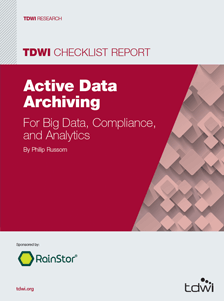
TDWI Checklist Report | Active Data Archiving for Big Data, Compliance, and Analytics
May 6, 2014
Data archiving presents various problems in the enterprise today.
Many organizations don’t archive at all. Others mistakenly think that
mere data backups can serve as archives, whereas tape is actually
the final burial place of data, from which it rarely returns. Equally off
base, others believe a data warehouse is an archive. Although it’s true
that data archiving processes exist today in some organizations, these
are rarely formalized or policy driven, such that data is archived in an
ad hoc fashion (typically per application or per department) without an
enterprise standard or strategy.
Even when an organization makes an honest attempt at an enterprise
data archive, the result is usually not trustworthy (because
data is easily altered), not auditable (due to poor metadata and
documentation), not compliant (due to inadequate usage monitoring or
the inability to purge data at specified milestones), and not properly
secured (lacking encryption, masking, and security standards).
Furthermore, with most existing data archives, it’s hard to get data in
with integrity and out with speed because the primary platform is not
online, active, and highly available.
Why don’t more organizations invest in formal archiving processes and
technical solutions? Most likely it’s their common belief that archives
provide little or no return on investment (ROI) because users rarely
(if ever) access the archive. Without prominent and frequent usage, a
respectable ROI is unlikely.
A data archive can achieve ROI by serving multiple uses and
users from an online, active platform. Yes, organizations do need
to retain data; that’s not in question. However, archived data is not
just insurance for compliance, audit, and legal contingencies. Those
are important goals, but a data archive should also be treated as an
enterprise asset to be leveraged, typically via analytics. Hence, a data
archive can be more than a cost center; it can achieve ROI when it
serves multiple uses (archiving, compliance, and analytics of deep
historical data sets) and it manages data online for active access at
any time by a wide range of users.
Users must start planning today for active data archiving. To help
them prepare, this TDWI Checklist report will drill into the desirable
attributes, use cases, user best practices, and enabling technologies
of active data archiving.